Case Report: 11CA008
Two laborers die from hydrogen sulfide exposure in a confined space at an organic waste recycling facility
Download a PDF to print this report:
Two laborers die from hydrogen sulfide exposure in a confined space at an organic waste recycling facility (11CA008, PDF)
Summary
Two laborers, 16 and 22-year-old brothers, died while cleaning the drainage system of an organic waste recycling facility. Both were exposed to excessive levels of hydrogen sulfide. The brothers were part of a three-man crew that was flushing out the drainage system consisting of 24-inch diameter underground pipes accessed by approximately 14 manhole shafts. While using a high-pressure water hose to flush residual compost, the 16-year-old was overcome by hydrogen sulfide and fell to the bottom of a 10-foot shaft. The 22-year-old collapsed at the bottom of the shaft after attempting to rescue his brother. Contributing factors identified in this investigation were the high concentration of hydrogen sulfide in the shaft, failure to implement a confined space and hazard communication program, and the age of the youngest victim. The CA/FACE investigator determined that, in order to prevent exposures to hydrogen sulfide while cleaning out drainage systems, employers should:
- Develop, implement, and enforce a comprehensive confined space program.
- Develop, implement, and enforce a hazard communication program.
- Hire only employees aged 18 or older for any work tasks that may involve confined spaces.
Introduction
On Wednesday October 12, 2011, at approximately 11:30 a.m., a 16-year-old Hispanic laborer working in an organic waste recycling facility died from asphyxiation when he was exposed to high levels of hydrogen sulfide. His 22-year-old brother, who was also exposed, died two days later. The CA/FACE investigator received notification of this incident on October 17, 2011, from the Richmond office of the California Department of Public Health, Occupational Health Branch. Contact with the employer was made on October 19, 2011, and the investigation took place at the incident site on Friday, October 21, 2011. Company managers, supervisor, co-workers of the victims, and employees involved in the incident were interviewed. Pictures were taken of the incident scene and copies of the police, coroner, and fire reports were also obtained.
Employer
The employer of the 16-year-old victim was a family-owned company that had been in business for 51 years. The company owned, operated, and managed an organic waste recycling facility, two biomass-fueled power plants, and a disposal plant. The organic waste recycling facility, where the incident occurred, had 125 employees and produced soil enhancement material by composting organic waste from multiple sources including green waste, produce from grocery stores, and urban tree trimmings.
The employer of the 22-year-old victim was an employment agency that specialized in fruit and machine harvesting and contracted its employees as laborers and skilled workers to local farmers, ranchers, and businesses. They had been in business since 1985 and employed 250 people.
Written Safety Programs and Training
The organic waste recycling facility engaged an outside safety contractor to supply them with a written safety management manual, hazard communication program, injury and illness prevention program (IIPP), and training. The IIPP contained elements that included hazard assessment, hazard correction, and job training. The IIPP did not contain a permit-required confined space program, nor did it identify the drainage system as a permit-required confined space. Although the employer stated that training was provided to the employees, records were not provided for verification. The labor contracting company had an IIPP but did not provide specific training to their employees.
Worker Information
The victims were brothers who came to the United States from the Mexico two years prior to the incident. The 16-year-old victim had been employed by the recycling company for three months. He presented identification that stated he was born in 1981 and was 30 years old. The employer submitted the information the victim provided to the Social Security Number Verification System (SSNVS) and the data submitted was verified as matching Social Security Administration records.
The 22-year-old victim initially went to work with his mother harvesting produce in the fields. The brothers then moved to live with other relatives and the older brother got a job with the crop harvesting company that contracted with the recycling company.
Environmental Conditions
The weather on the day and time of the incident was clear with no wind and a temperature of 65 degrees Fahrenheit.
Hydrogen Sulfide (H2S)
Hydrogen sulfide is a colorless, flammable, extremely hazardous gas with a "rotten egg" smell. It occurs naturally in crude petroleum, natural gas, and hot springs. In addition, H2S is produced by bacterial breakdown of organic materials and human and animal wastes (e.g., sewage). Industrial activities that can produce the gas include petroleum/natural gas drilling and refining, wastewater treatment, coke ovens, tanneries, and paper mills. H2S can also exist as a liquid compressed gas. H2S is heavier than air and may travel along the ground. It collects in low-lying and enclosed, poorly-ventilated areas such as basements, manholes, sewer lines, underground telephone vaults, and manure pits.
The primary route of exposure is inhalation and the gas is rapidly absorbed by the lungs. Absorption through the skin is minimal. People can smell the "rotten egg" odor of H2S at low concentrations in air. However, with continuous low-level exposure, or at high concentrations, a person loses his/her ability to smell the gas even though it is still present. This can happen very rapidly and at high concentrations; the ability to smell the gas can be lost instantaneously. In addition, H2S is a highly flammable gas and gas/air mixtures can be explosive. It may travel to sources of ignition and flash back. If ignited, the gas burns to produce toxic vapors and gases, such as sulfur dioxide.
H2S is classed as a chemical asphyxiant, similar to carbon monoxide and cyanide gases. It inhibits cellular respiration and uptake of oxygen, causing biochemical suffocation. Symptoms of a low exposure of 0-10 parts per million (ppm) include irritation of the eyes, nose, and throat. Moderate exposure of 10-50 ppm can result in headache, dizziness, nausea, vomiting, coughing, and breathing difficulty. High exposure of 50-200 ppm causes severe respiratory tract irritation, eye irritation, acute conjunctivitis, shock, convulsion, coma, and death.
Facility Description
The incident occurred on a multi-acre organic waste recycling facility where organic materials from commercial and residential sites were turned into compost. Organic materials were piled into large wind rows (a long row) and treated with water and chemicals to speed biodegradation. A storm drain system below ground carried water and debris to a catch basin on the property.
The drainage system consisted of 24-inch diameter drainage pipes strategically angled beneath the soil and 14 vertical shafts (manholes) ranging in depths of 4 to 10 feet and 36 inches in diameter. Each of the vertical drainage shafts was covered with a solid metal plate. The vertical shaft involved in this incident was 10 feet in depth, six feet in diameter at its base, and had three drainage pipes leading in and one pipe exiting toward the catch basin.
Investigation
The day before the incident, the two victims and another employee were assigned the task of flushing out the drainage system. This was an annual job assignment done in the fall season. The instructions given to the workers by their supervisor were to shovel off any debris on top of the shaft covers, remove the shaft covers, and then deluge the shafts with low-pressure water from a 3,000-gallon-capacity water truck. If this process didn't remove all the debris, then they were to use the high-pressure water hose on the truck to remove the unwanted debris.
On the day of the incident, the workers were taking turns spraying water from the high pressure hose. All three took turns sitting on the edge of the shaft and directing the water stream to the bottom of the shaft. This proved unsuccessful in cleaning out the hole, so they placed an eight-foot ladder into the shaft. The 16-year-old victim was standing on the ladder inside the shaft to aim the spray of water. The 22-year-old victim witnessed his brother collapsing into the shaft, went down the ladder to rescue him, and then was overcome himself. The third employee looked down the shaft; saw both co-workers unresponsive and called for help. The fire department arrived at the incident scene and determined that hydrogen sulfide was present. The rescue team entered the shaft wearing self-contained-breathing-apparatus (SCBA) to rescue the victims. The 16-year-old was pronounced dead on arrival at the hospital, and the 22-year-old survived for two days before he was taken off life support.
Contributing Factors
Occupational injuries and fatalities are often the result of one or more contributing factors or key events in a larger sequence of events that ultimately result in an injury or fatality. The CA/FACE team identified the following items as contributing factors in this incident that ultimately led to the fatality:
- Lack of training in hazardous substance identification and confined space procedures.
- Presence of hydrogen sulfide gas.
- Lack of ventilation.
- The age of the younger victim.
Cause of Death
The cause of death (for both victims) according to the death certificate was hydrogen sulfide intoxication.
Recommendations
In order to prevent exposures to hydrogen sulfide while cleaning out drainage systems, employers should:
Recommendation #1: Develop, implement, and enforce a comprehensive confined space program.
Discussion: In this incident, both workers were overcome by dangerous levels of hydrogen sulfide. California OSHA's Confined Space Standard contains specific requirements for identifying, monitoring, and entering confined spaces. If employees must work inside a permit-required confined space such as a drainage system, the required confined space procedures should always be followed. Permit-required confined space procedures should always include the following:
- Air testing, monitoring, and documentation.
- Mechanical ventilation as feasible.
- Proper respiratory protection.
- Proper personal protective equipment (PPE).
- Communications protocols.
- Medical surveillance.
- Proper rescue and retrieval procedures.
- Training.
Before entering areas where H2S may be present:
- The air must be tested for the presence and concentration of H2S by a qualified person using air monitoring equipment, such as hydrogen sulfide detector tubes or a multi-gas meter that detects the gas. Testing should also determine if fire/explosion precautions are necessary.
- If H2S gas is present, the space/area must be ventilated continually to remove the gas.
- If the gas cannot be removed, the person entering the space/area must use appropriate respiratory protection and any other necessary personal protective equipment, rescue, and communication equipment. A level of H2S gas at or above 100 parts per million (ppm) is immediately dangerous to life and health (IDLH). Entry into IDLH atmospheres can only be made using:
- A full face-piece pressure-demand self-contained breathing apparatus (SCBA) with a minimum service life of thirty minutes, or
- A combination full face-piece pressure-demand supplied-air respirator with an auxiliary self-contained air supply.
If H2S levels are below 100 ppm, an air-purifying respirator may be used, assuming the filter cartridge/canister is appropriate for hydrogen sulfide. A full face-piece respirator will prevent eye irritation. If air concentrations are elevated, eye irritation may become a serious issue. If a half-mask respirator is used, tight-fitting goggles must also be used. Workers in areas containing hydrogen sulfide must be constantly monitored for signs of overexposure.
Although the shaft and drainage system were permit-required confined spaces, this was not identified by the employer and therefore no permit confined space procedures were in place. Had the employer identified the shaft as a permit-required confined space with a hazardous atmosphere containing high levels of H2S, and had they provided the proper training, tools, and equipment to their employees to work safely, this incident might have been prevented.
Recommendation #2: Develop, implement, and enforce a hazard communication program.
Discussion: The employer had a written hazard communication program but did not have any specific information about the hazards of composting (including hydrogen sulfide dangers). The victims most likely did not know that one of the dangers of composting is the production of toxic hydrogen sulfide gas that can build up to lethal concentrations in shafts and drainage systems. Hydrogen sulfide production during composting is well-recognized within the industry. The employer did not have any training or education program for their employees in hazard recognition specific for hydrogen sulfide. Under California law, all employers must provide information and training to their employees about the hazardous substances to which they may be exposed in their work area through a hazard communication program. This training must be provided at the time of their initial assignment, and whenever a new hazard is introduced into their work area. The information and training should include:
- Any operations in their work area where hazardous substances are present.
- The location and availability of the written hazard communication program, including the list(s) of hazardous substances and material safety data sheets.
- The methods and observations used to detect the presence or release of a hazardous substance in the work area.
- The physical and health hazards of the substances in the work area, and the measures needed to take to protect themselves from these hazards, including specific procedures the employer has implemented to protect employees from exposure to hazardous substances such as appropriate work practices, emergency procedures, and the PPE to be used.
- An explanation of the labeling system and the material safety data sheet, and how employees can obtain and use the appropriate hazard information.
Had a hazard communication program been developed and implemented by the employer, the employees might have recognized the foul odor of H2S and taken the proper precautions, thereby preventing this incident.
Recommendation #3: Hire only employees aged 18 or older for any work tasks that may involve confined spaces.
Discussion: Confined space hazards are a danger to workers of all ages, and require detailed training, personal protective equipment (PPE), and attention to procedures under the existing regulations. In general, workers less than 18 years of age are particularly vulnerable in this type of situation. They do not possess the experience, or physical and emotional maturity of older workers. In some states, child labor laws do not permit children less than 18 years of age to work in many hazardous environments or perform activities considered to be too dangerous for their age. This is based on evidence that youth are at greater risk for injury or exposures and their effects for a variety of reasons. In particular, they are not fully developed neurologically to manage complex situations and have limitations of certain problem-solving abilities. Young workers may feel invulnerable and are more likely to engage in high-risk activities. Young workers may not have developed adequate judgment to determine if a particular activity is hazardous.
In this case, the 16-year-old victim was given the task of cleaning a permit-required confined space where hydrogen sulfide was present. A 16-year-old is particularly at risk of injury or death if they lack the experience to recognize the symptoms of toxic exposure or minimize the possible effects or symptoms of toxic exposure; lack the ability to report adverse symptoms; or have limited options for refusing to perform the work. It is also known that due to differences in how substances are metabolized among different age groups, children and adolescents may also have greater impacts of chemical exposure at lower levels than adults. In this incident, it is not known exactly why the 16-year-old brother descended into the shaft. However, he may not have understood that a life-threatening hazard was present, felt relatively invulnerable, or he may have wanted to perform well in front of his peers. If the 16-year-old had not been assigned to perform this task, both brothers' deaths might have been prevented.
Exhibits
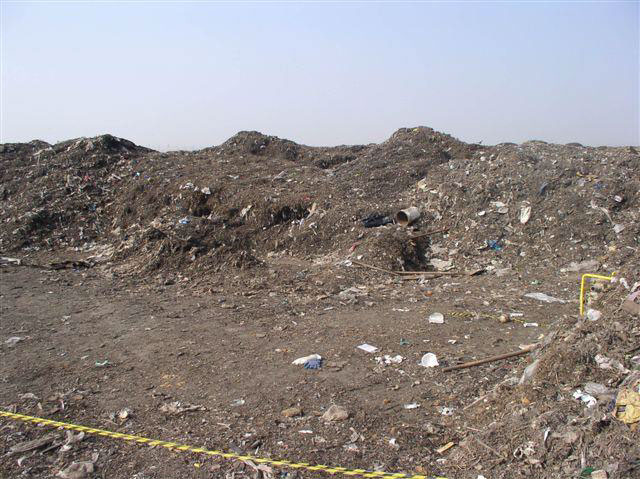
Exhibit 1. The incident scene.
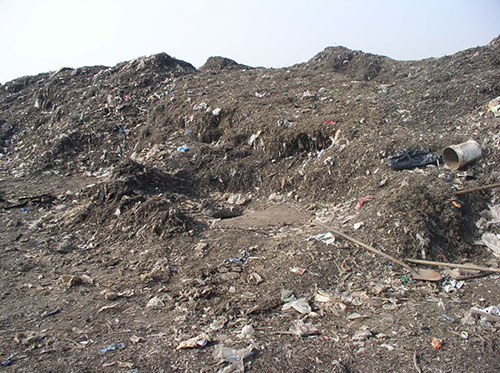
Exhibit 2. The shaft opening.
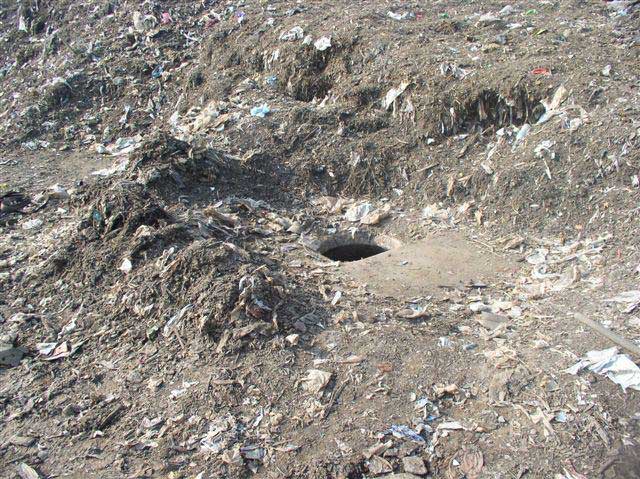
Exhibit 3. The shaft opening.
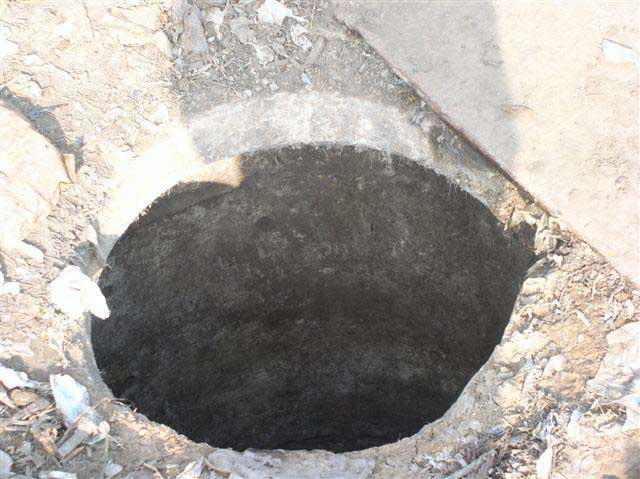
Exhibit 4. A close-up of the shaft opening.
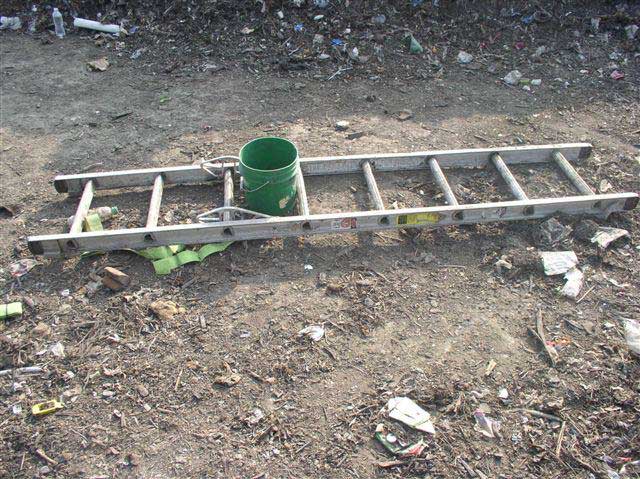
Exhibit 5. The ladder found in the shaft opening.
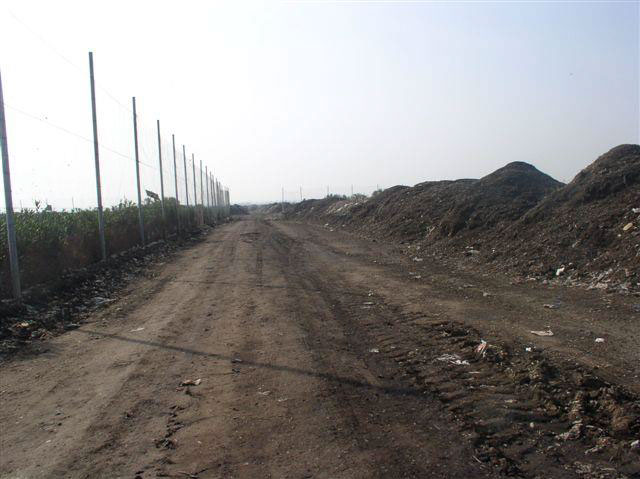
Exhibit 6. The wind rows of compost at the recyling compound.
References
California Code of Regulations - Subchapter 7. General Industry Safety Orders
Group 1. Introduction
§3203. Injury and Illness Prevention Program.
Group 16. Control of Hazardous Substances
Article 108. Confined Spaces
§5156. Scope, Application and Definitions.
§5157. Permit-Required Confined Spaces.
§5158. Other Confined Space Operations.
Article 109. Hazardous Substances and Processes
§5194. Hazard Communication.
Article 110. Regulated Carcinogens
§5202. Methylene chloride.
HYDROGEN SULFIDE (CASE No. 7783-06-4) In Support of Summary Information on the Integrated Risk Information System (IRIS), June 2003. U.S. Environmental Protection Agency Washington, DC
TOXICOLOGICAL PROFILE FOR HYDROGEN SULFIDE
U.S Department of Health and Human Services -Public Health Service Agency for Toxic Substances and Disease Registry July 2006
YouthRules! - U.S. Department of Labor, Wage and Hour Division website with information pertaining to child labor laws
DOL [February 2013]. Child Labor Requirements in Non-Agricultural Occupations under the Fair Labor Standards Act. Washington, DC: U.S. Department of Labor, Wage and Hour Division, WH-1330. Child Labor Bulletin No. 101.
Protecting Youth at Work: Health, Safety, and Development of Working Children and Adolescents in the United States / Committee on the Health and Safety Implications of Child Labor, Board on Children, Youth, and Families, Commission on Behavioral and Social Sciences and Education, National Research Council, Institute of Medicine. 1998 DOL [July 2010].
Fact Sheet #43: Child Labor Provisions of the Fair Labor Standards Act for Non-Agricultural Occupations (PDF) - U.S. Department of Labor.
Authors
Hank Cierpich, FACE Investigator
Robert Harrison, MD, MPH, FACE Project Officer
Laura Styles, MPH, Research Scientist
June 7, 2013